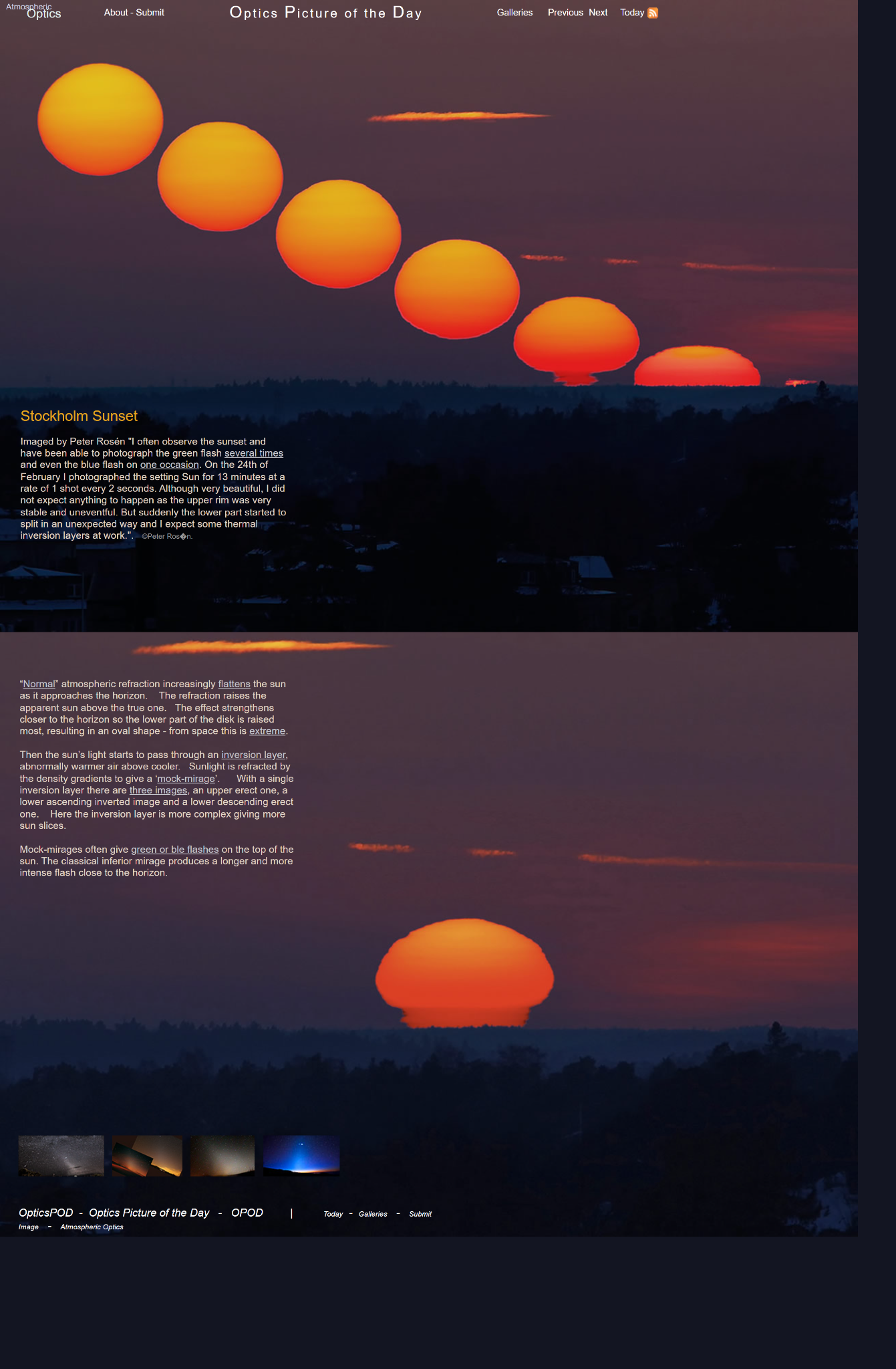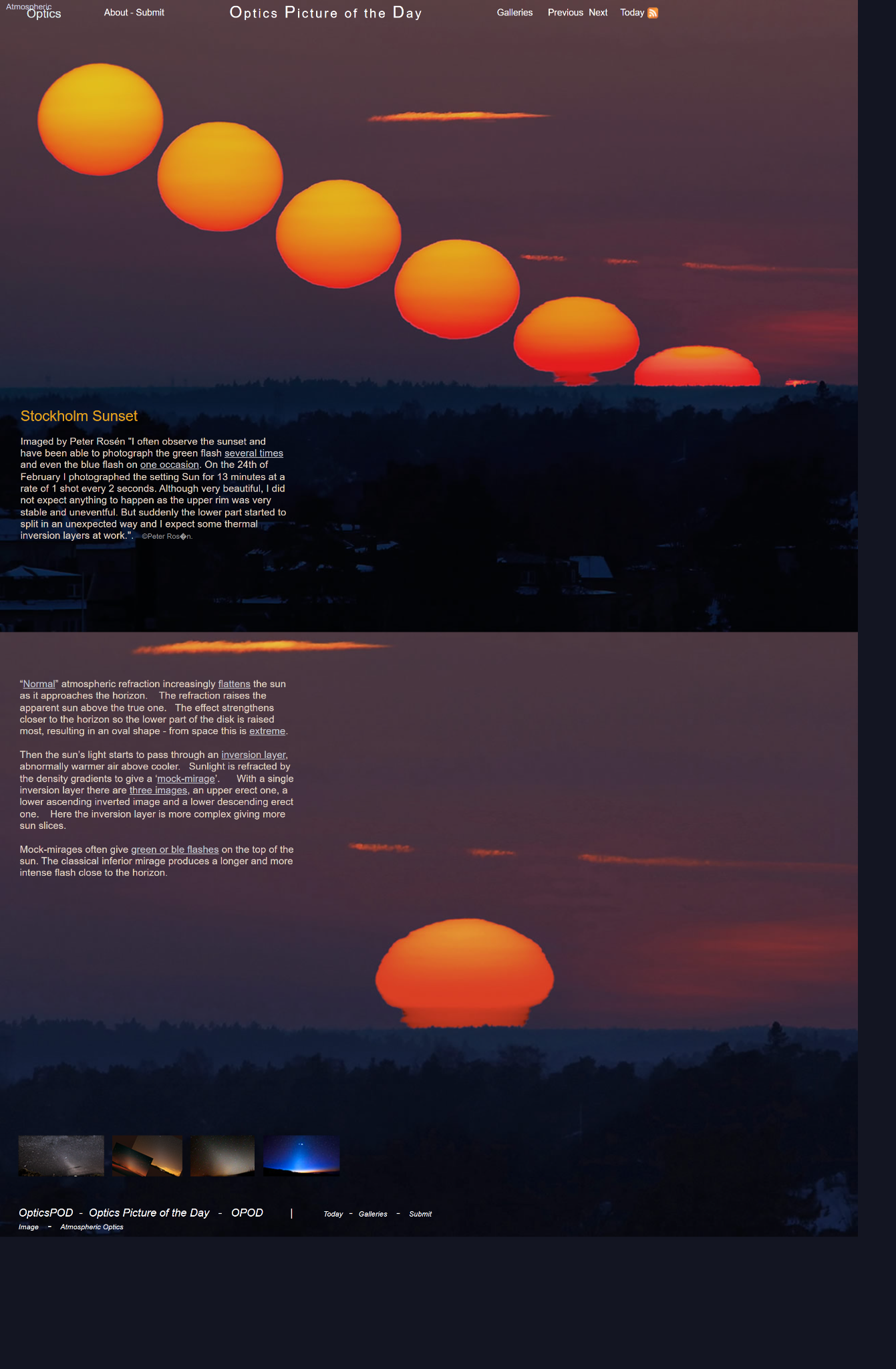OPOD - Stockholm Sunset
OPOD - Stockholm Sunset: A Captivating Atmospheric Phenomenon
The mesmerizing beauty of a sunset never fails to captivate our senses. The interplay of colors and the gradual descent of the sun below the horizon create a spectacle that is both serene and awe-inspiring. However, there are occasions when a sunset in Stockholm offers more than just its natural splendor. It unveils a fascinating atmospheric optics phenomenon that leaves observers amazed and intrigued.
Renowned photographer Peter Rosén shares his experience of photographing a Stockholm sunset on the 24th of February. With meticulousness, he captured the setting sun for 13 minutes, taking a shot every 2 seconds. Little did he expect that his patience would be rewarded with an unexpected display of atmospheric wonder.
As the images reveal, the upper rim of the sun appeared stable and uneventful. However, the lower part began to split in an extraordinary manner, defying expectations. Rosén suggests that this intriguing occurrence could be attributed to thermal inversion layers at work.
Unveiling the Mysteries of Atmospheric Refraction
The phenomenon observed in the Stockholm sunset can be attributed, in part, to "normal" atmospheric refraction. As the sun approaches the horizon, its shape becomes increasingly flattened due to refraction. This refraction causes the apparent sun to be raised above its true position. Interestingly, this effect is more pronounced closer to the horizon, resulting in an oval-shaped sun when viewed from space.
The Role of Inversion Layers in Creating Optical Illusions
The Stockholm sunset goes beyond the typical effects of atmospheric refraction. The sun's light passes through an inversion layer, characterized by abnormally warmer air above cooler air. The density gradients within this layer refract sunlight in unique ways, giving rise to what is known as a "mock-mirage."
In the presence of a single inversion layer, three images of the sun can be observed. An upper erect image, a lower ascending inverted image, and a lower descending erect image create a striking visual phenomenon. However, in the case of the Stockholm sunset, the inversion layer is more complex, resulting in an even greater number of sun slices.
The Enigmatic Green and Blue Flashes
Mock-mirages, such as those witnessed during the Stockholm sunset, often exhibit flashes of green or blue on the top of the sun. These flashes are a result of the unique optical properties of the inversion layer. The classical inferior mirage, which occurs close to the horizon, can produce a longer and more intense flash.
Exploring Further
If you find yourself intrigued by the Stockholm sunset phenomenon and wish to delve deeper into atmospheric optics, there are numerous resources available. Websites dedicated to atmospheric phenomena offer a wealth of information and stunning visuals. Additionally, books on meteorology and atmospheric science can provide a comprehensive understanding of the underlying principles.
Conclusion
The Stockholm sunset serves as a reminder of the wonders that await us in the natural world. Through the lens of a skilled photographer like Peter Rosén, we gain insight into the intricate workings of atmospheric optics. As we marvel at the split sun and the dance of colors, we are reminded of the complex interplay between light and air. So, next time you witness a sunset, take a moment to appreciate the hidden beauty that lies within. Who knows what captivating atmospheric phenomena await your gaze?

Stockholm Sunset
Imaged by Peter Rosén "I often observe the sunset and have been able to photograph the green flash several times and even the blue flash on one occasion. On the 24th of February I photographed the setting Sun for 13 minutes at a rate of 1 shot every 2 seconds. Although very beautiful, I did not expect anything to happen as the upper rim was very stable and uneventful. But suddenly the lower part started to split in an unexpected way and I expect some thermal inversion layers at work.". ©Peter Ros�n.

“Normal” atmospheric refraction increasingly flattens the sun as it approaches the horizon. The refraction raises the apparent sun above the true one. The effect strengthens closer to the horizon so the lower part of the disk is raised most, resulting in an oval shape - from space this is extreme.
Then the sun’s light starts to pass through an inversion layer, abnormally warmer air above cooler. Sunlight is refracted by the density gradients to give a ‘mock-mirage’. With a single inversion layer there are three images, an upper erect one, a lower ascending inverted image and a lower descending erect one. Here the inversion layer is more complex giving more sun slices.
Mock-mirages often give green or ble flashes on the top of the sun. The classical inferior mirage produces a longer and more intense flash close to the horizon.
Note: this article has been automatically converted from the old site and may not appear as intended. You can find the original article here.
Reference Atmospheric Optics
If you use any of the definitions, information, or data presented on Atmospheric Optics, please copy the link or reference below to properly credit us as the reference source. Thank you!
-
<a href="https://atoptics.co.uk/blog/opod-stockholm-sunset/">OPOD - Stockholm Sunset</a>
-
"OPOD - Stockholm Sunset". Atmospheric Optics. Accessed on November 24, 2024. https://atoptics.co.uk/blog/opod-stockholm-sunset/.
-
"OPOD - Stockholm Sunset". Atmospheric Optics, https://atoptics.co.uk/blog/opod-stockholm-sunset/. Accessed 24 November, 2024
-
OPOD - Stockholm Sunset. Atmospheric Optics. Retrieved from https://atoptics.co.uk/blog/opod-stockholm-sunset/.